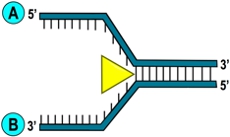During DNA replication, the process involves the formation of two distinct strands at each replication fork: the leading strand and the lagging strand. The leading strand is synthesized continuously in the same direction as the movement of the replication fork. This continuous replication requires only a single RNA primer to initiate the process. In contrast, the lagging strand is synthesized discontinuously, moving in the opposite direction of the replication fork. This results in the formation of multiple short segments known as Okazaki fragments, which are named after the Japanese scientist who discovered them.
Each Okazaki fragment on the lagging strand necessitates its own RNA primer, leading to the requirement of multiple primers for the entire lagging strand. After the fragments are synthesized, they are covalently joined together by the enzyme DNA ligase, which facilitates the completion of the lagging strand. The replication process begins at a specific location called the origin of replication, where the DNA unwinds to form a replication bubble, allowing for the simultaneous synthesis of both strands.
It is important to note that DNA polymerase, the enzyme responsible for synthesizing new DNA, can only add nucleotides in the 5' to 3' direction. This limitation is why the lagging strand must be synthesized in short segments rather than continuously. Ultimately, the RNA primers used in both strands are replaced with DNA, ensuring that the final product is a complete and accurate DNA molecule.



